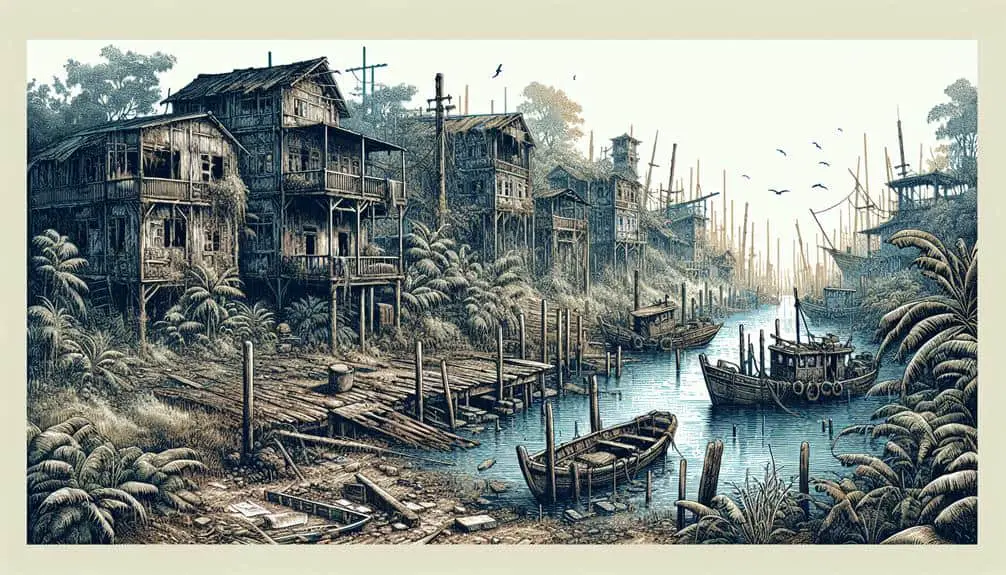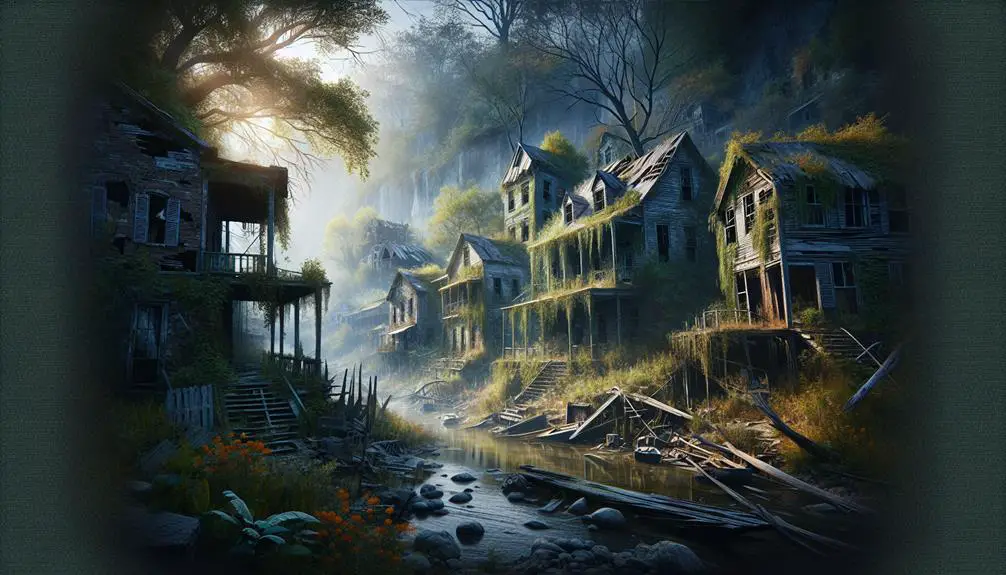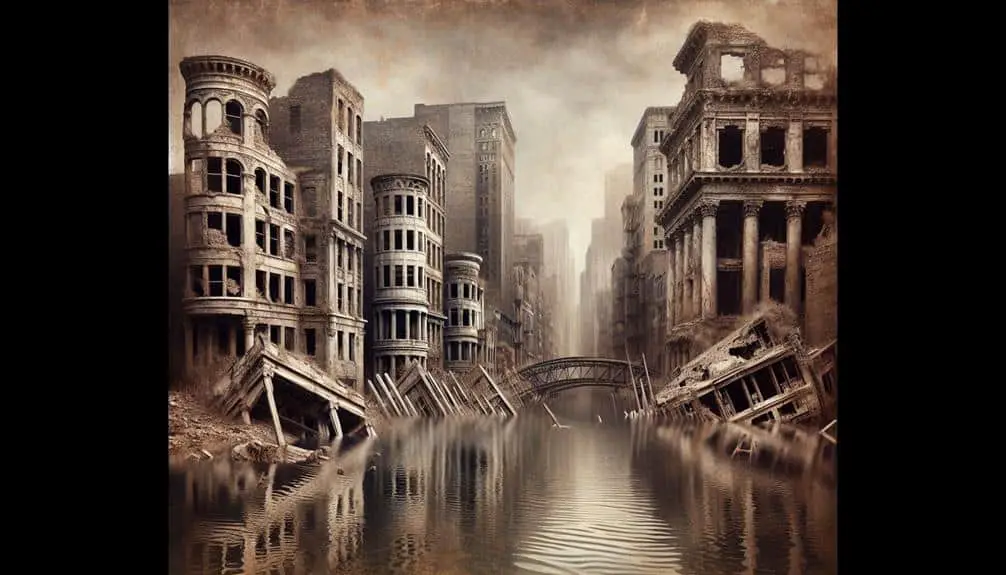Sunken towns exist along US rivers due to erosion, geological shifts, human actions, and natural disasters. These submerged communities hold rich cultural heritage and offer insights into past ways of life. Neglected by rapid urban development, they reveal intricate relationships between settlements and the environment. Flooding not only damages infrastructure and displaces populations but also threatens historical and cultural significance. Preservation efforts, including community engagement and underwater archaeology, aim to sustain these submerged towns and reveal valuable historical knowledge. Uncover the stories hidden beneath the water's surface, waiting to be explored further.
Key Points
- Erosion and geological shifts weaken riverbanks.
- Human interventions disrupt natural drainage systems.
- Natural disasters like hurricanes cause sudden flooding.
- Rising river levels submerge towns along riverbanks.
- Changing landscapes neglect submerged communities.
Historical Significance of Sunken Towns
The historical significance of sunken towns lies in their ability to serve as fascinating windows into the past, revealing layers of human history submerged beneath the waters of US rivers. These submerged towns hold a wealth of cultural heritage waiting to be explored. Each sunken town tells a unique story of urban development, providing valuable insights into the growth and evolution of communities along the rivers.
By studying these sunken towns, historians and archaeologists can uncover important clues about the daily lives, social structures, and economic activities of past inhabitants. The remains of buildings, streets, and artifacts offer a glimpse into the architectural styles, livelihoods, and technological advancements of bygone eras. Understanding the reasons behind the submergence of these towns is vital for piecing together the puzzle of American history and heritage.
Exploring sunken towns along US rivers not only enriches our knowledge of the past but also prompts us to reflect on the impact of human actions on the environment and the consequences of rapid urbanization. The preservation and study of these submerged sites are essential for preserving our cultural legacy and learning from the mistakes of the past.
Causes of Towns Submerging
Submersion of towns along US rivers often stems from a complex interplay of geological shifts, human interventions, and natural disasters. When examining the causes of towns submerging, it becomes evident that erosion effects and geological shifts play a significant role in altering the landscape.
Here's a breakdown of why towns end up submerged:
- Erosion Effects: Over time, the relentless force of water erodes riverbanks and surrounding areas, causing land to gradually give way and be submerged by rising river levels.
- Geological Shifts: Movements in the Earth's crust can lead to changes in the topography, causing once stable land to shift and become prone to flooding and submersion.
- Human Interventions: Human activities such as dam constructions, deforestation, and urban development can disrupt natural drainage systems, exacerbating the risk of towns being submerged.
- Natural Disasters: Events like hurricanes, heavy rainfall, or snowmelt can result in sudden and catastrophic flooding, leading to the submersion of towns along riverbanks.
Forgotten Communities Along River Banks
As we explore the overlooked history of sunken towns along US rivers, a poignant narrative emerges about the forgotten communities that once thrived on the banks. These settlements, now submerged under the waters, hold a significant cultural heritage that often goes unnoticed. The rapid urban development and changing landscapes along the rivers have led to the neglect of these once vibrant towns, erasing their stories from the collective memory.
The remnants of these sunken towns serve as a reminder of the intricate relationship between human settlements and the natural environment. The process of towns submerging not only highlights the power of nature but also raises questions about the sustainability of urban development near riverbanks. It's essential to preserve the cultural heritage of these forgotten communities as they contribute to the tapestry of American history, offering insights into past ways of life and the consequences of neglecting our connection to the land.
Impact of Flooding on Towns
Flooding drastically alters the landscape and infrastructure of towns along rivers, reshaping the environment and challenging the sustainability of urban development. When floods strike, they bring about significant transformations with lasting impacts:
- Economic Repercussions: The destruction caused by flooding can lead to significant economic losses for businesses and residents, affecting the overall prosperity of the town. Rebuilding and recovery efforts require substantial financial investments.
- Infrastructure Damage: Floodwaters can damage roads, bridges, and utilities, disrupting daily life and hindering transportation. Reconstructing these essential structures is vital for the town to function effectively.
- Cultural Heritage Threat: Floods can endanger historical buildings, artifacts, and sites that hold cultural significance to the community. Preserving these elements of cultural heritage becomes a challenge in the face of recurrent flooding.
- Population Displacement: In severe cases, flooding can force residents to evacuate their homes, leading to temporary or permanent displacement. This displacement can strain resources and impact the social fabric of the town.
Preservation Efforts for Sunken Towns
Preserving sunken towns presents a unique challenge that requires innovative strategies and collaborative efforts to safeguard historical and cultural treasures from the perils of water damage. Community engagement plays an essential role in the preservation of sunken towns, as involving local residents in conservation efforts fosters a sense of ownership and pride in their shared heritage. By working together, communities can raise awareness, gather resources, and implement sustainable preservation plans.
Underwater archaeology is another critical aspect of preserving sunken towns. Through meticulous excavation and documentation of submerged sites, researchers can uncover valuable insights into the past while ensuring that artifacts are properly conserved and protected. This interdisciplinary approach combines historical research, scientific analysis, and cultural stewardship to piece together the stories of sunken towns for future generations.
Frequently Asked Questions
How Do Sunken Towns Impact the Local Ecosystem Along US Rivers?
As you explore how sunken towns impact the local ecosystem along US rivers, consider the profound ecological impact they have. These submerged remnants can affect water quality, biodiversity conservation, and habitat restoration efforts in unique ways.
Are There Any Legends or Myths Surrounding the Sunken Towns Along US Rivers?
Legends and myths surrounding sunken towns along US rivers are rich with tales of lost souls, buried treasures, and mysterious disappearances. These stories add a layer of intrigue and folklore to these submerged communities.
What Role Did Industrialization Play in the Submerging of Towns Along US Rivers?
Industrialization greatly impacted the submerging of towns along US rivers. The historical significance lies in how increased urban development and dam constructions altered river courses, leading to the inundation of settlements over time.
How Do Sunken Towns Affect Property Values and Development Along River Banks?
When it comes to sunken towns affecting property values and riverfront development, the sunken history can both intrigue and deter buyers. The allure of unique stories may clash with concerns about potential risks or limitations.
Are There Any Unique Architectural Features or Artifacts That Have Been Preserved From Sunken Towns?
Explore the depths to uncover unique artifacts and architectural features preserved in sunken towns. Their historical significance and cultural heritage offer a window into the past. Underwater exploration reveals a world frozen in time.



